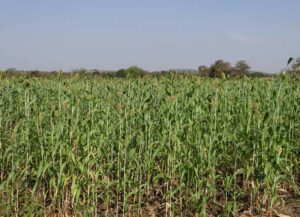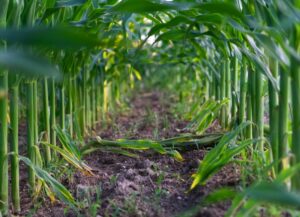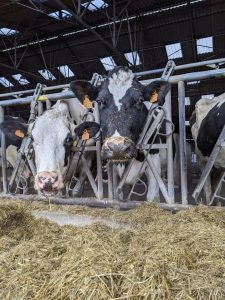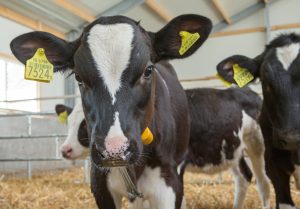Alvaro Garcia
Growing forages in arid regions of the world is one of the biggest constraints to profitable intensive dairy production. Under these conditions dairy production systems rely heavily on forages that require less water together with mostly imported grain. In addition, dairy rations tend to include higher concentrate to forage ratios since it makes more economic sense to transport energy dense feeds (grain) than roughage.
In Israel for example, total mixed rations (TMR) fed to dairy cows contain 33–36% roughage, a bare minimum needed to supply 18–19 % neutral detergent fiber (NDF) needed in order to minimize the risk of acidosis. As a result, winter forages such as wheat (Triticum spp.) supply nearly 70% of the annual forage, complemented with corn silage during the summer irrigated with recycled water.
Wheat and barley forages
Nearly 40,000 Ha of wheat both for silage and hay are grown yearly as the main winter forage in Israel, followed by barley (Hordeum vulgare L.) with only 2,500 Ha for silage and 3,500 Ha as grain for feeding. Wheat is an important crop in this system since it provides flexibility, switching from grain to forage and vice versa depending on environmental conditions.
Barley’s yield, quality, and nutritive value are less known at the present time particularly of those cultivars grown for silage in the same fields and under similar conditions as wheat. One of the advantages of barley in this semi-arid environment is that it apparently uses water more efficiently, it has early vigor, and matures faster compared to wheat resulting in higher yields per Ha.
A recent study (Bikel et al. 2020) looked at: 1) barley yields compared to wheat grown in the same field and harvested at the optimal dry matter (DM) content for ensilage and hay-making; 2) chemical composition and in-vitro digestibility of wheat and barley silages and hays; and 3) the effects on eating behavior, digestibility, rumen pH, rumination time, and production performance, when high-yielding lactating dairy cows were fed a TMR containing barley silage and hay instead of wheat silage and hay.
A commercial barley and wheat cultivars were sown on November 15, 2017 (210 and 170 seed/m2, for wheat and barley, respectively) and grown in the same plot (two subplots of 5 ha each) in a sandy loam soil field. Total rainfall during growth was 210 mm, and fertilization was with 100 kg urea/Ha, with 25 kg urea/Ha applied later and before a second rain event. Both wheat and barley were harvested on March 20, 2018.
Both crops had similar DM content (35.6%) at ensiling time but were at different developmental stages, with wheat at three fourths grain filling stage and barley at mature grain stage. Subplots were harvested weighed, sampled and ensiled in 2-L glass micro silos for measurement of DM losses during ensiling.
Two-thirds of each fresh crop were harvested in the field, collected and chopped directly into trucks, and then ensiled in polyethylene-wrapped bales. The remaining one-third of each harvested cultivar was wilted in the field for 2 weeks before being harvested as hay bales.
High-yielding multiparous Holstein cows were paired into two experimental groups fed either wheat- or barley-based TMRs ad libitum for 28 days as follows:
- 0% barley silage and 6.0% barley hay in a DM basis
- 0% wheat silage and 6.0% wheat hay in a DM basis
Advantages of barley forage compared to wheat forage
Results of this study showed that when grown under similar conditions, barley yielded 19% more DM biomass compared to wheat, while both had similar composition and in-vitro digestibility. When fed to the cows, barley silage and hay TMR had higher in-vivo digestibility and resulted in higher milk fat yields and production efficiency compared to the wheat silage and hay TMR.
The authors attributed this to the improved rumen pH conditions and rumination time in the cows fed barley forages. Dry matter intake was higher for the wheat TMR compared to the barley TMR-fed cows (28.0 vs. 27.5 kg/day), with a faster eating rate (137.9 vs. 132.9 g DM/min), and larger meal size.
Energy corrected milk production was similar for both TMRs (42.4 and 42.8 kg/day), while milk fat yield was higher in the barley-fed cows (1.62 vs. 1.57 kg/day). Daily rumination with the barley TMR was longer (577 vs. 537 min/day) and rumen pH higher during the day and night compared to the wheat-TMR treatment.
In-vivo DM digestibility and neutral detergent fiber digestibility were higher in the barley-fed cows.
These results show that barley derived forages outperform wheat forages in semiarid regions making it advantageous for high productive cows.
Reference
Daniel Bikel, Yehoshav Ariel Ben-Meir, Yoav Shaani, Ran Solomon, Idan Richker, Yuri Portnik, Shamay Jacoby, Joshua Miron, Roi Ben-David. Nutritive value for high-yielding lactating cows of barley silage and hay as a substitute for wheat silage and hay in low-roughage diets. Animal Feed Science and Technology 265 (2020) 114498.
© 2020 Dairy Knowledge Center. All Rights Reserved.









